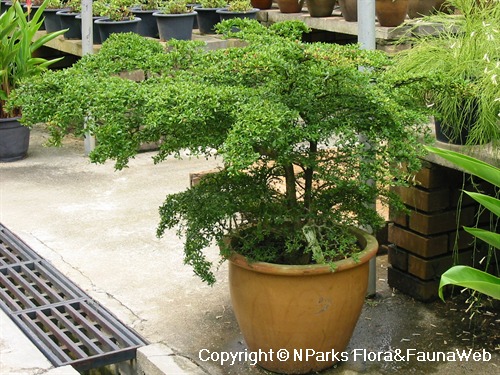
Back
Terminalia molinetii M. Gómez
| Family Name: | Combretaceae |
| Common Name: | Spiny Black Olive, Dwarf Geometry Tree, Spiny Bucida, Ming Tree |
Name
Classifications and Characteristics
| Plant Division | Angiosperms (Flowering Seed Plants) (Dicotyledon) |
|---|---|
| Plant Growth Form | Shrub, Tree (Small (6m-15m), Shrubby (1m-5m)) |
| Lifespan (in Singapore) | Perennial |
| Mode of Nutrition | Autotrophic |
| Plant Shape | Umbrella |
| Maximum Height | 3 m to 7 m |
Biogeography
| Native Distribution | Caribbean, USA (Florida) |
|---|---|
| Native Habitat | Terrestrial (Coastal Forest, Grassland / Savannah/ Scrubland), Shoreline (Mangrove Forest) |
| Preferred Climate Zone | Tropical |
Description and Ethnobotany
| Others - Plant Morphology | Shrub or small tree, up to 7m height. Leaves small (0.6-2cm long x 0.5cm wide), glossy dark green above, lighter green below, young leaves reddish; leathery, produced in whorls at nodes, clustered at branch tips, semi-deciduous. Flowers tiny (0.5cm across), creamy white, in clusters. Fruits small clustered drupes (0.5cm), ovoid, angled, ripen from green to tan to brown in 2 months.Stiff spines found along stems and at base of leaves. Crown may be layered / tiered when plant is young, but becomes oval to round, denser and flattened out with age. Crown exhibits lacy silhouette due to horizontally-zigzag branching pattern.Slow-growing. Prefers frequent fertilization. Grown as bonsai (thereby known as Ming Tree in America), and suitable as specimen plants in containers. |
|---|---|
| Ethnobotanical Uses | Food (Herb or Spice) Others: Bark mixed with bark of Rhizophora mangle to stop bleeding. |
Landscaping Features
| Landscape Uses | Container Planting, Coastal, Suitable for Bonsai, Interiorscape/ Indoor Plant, Beachfront / Shoreline |
|---|---|
| Thematic Landscaping | Rockery / Desert Garden, Formal Garden |
| Usage Hazard - Cons | Spines/Thorns - Stem/Branch |
| Usage Hazard - Cons Remarks | Stiff spines (1-3cm) found along stems & base of leaf whorls |
| Plant & Rootzone Preference or Tolerance Remarks | Likes moist soils. |
Plant Care and Propagation
| Light Preference | Full Sun, [Remarks] (Drought-tolerant when established.) |
|---|---|
| Water Preference | Moderate Water, Little Water, [Remarks] (Drought-tolerant when established.) |
| Plant Growth Rate | Slow |
| Rootzone Tolerance | Saline Soils / Salt Spray, Drought Tolerant |
| Maintenance Requirements | Low |
| Pruning | Prune to shape into bonsai. |
| Propagation Method | Seed, Stem Cutting |
Foliar
| Foliage Retention | Drought / Semi-Deciduous |
|---|---|
| Mature Foliage Colour(s) | Green |
| Mature Foliage Texture(s) | Glossy / Shiny, Leathery, Thick |
| Prominent Young Flush Colour(s) | Red |
| Foliar Modification | Spine (axillary) |
| Foliar Type | Simple / Unifoliate |
| Foliar Arrangement Along Stem | Whorled |
| Foliar Shape(s) | Non-Palm Foliage (Oval) |
| Foliar Venation | Pinnate / Net |
| Foliar Margin | Entire |
| Foliar Apex - Tip | Obtuse, Rounded |
| Foliar Base | Cuneate |
| Typical Foliar Area | Nanophyll ( 0.25cm2 - 2.25 cm2 ) |
| Leaf Area Index (LAI) for Green Plot Ratio | 3.0 (Tree - Intermediate Canopy) |
Non - Foliar and Storage
| Trunk Type (Non Palm) | Woody |
|---|---|
| Bark Colour(s) | Rough, greyish brown. Terminal stem twigs reddish. |
| Mature Bark Texture | Peeling / Flaking / Papery, Scaly |
| Stem Type & Modification | Woody |
| Root Type | Underground (Tap Root, Fibrous Root) |
| Mature Bark Texture Remarks | Rough bark |
Floral (Angiosperm)
| Flower & Plant Sexuality | Bisexual Flowers |
| Flower Colour(s) | Cream / Off-White |
|---|---|
| Flower Symmetry | Radial |
| Flower Size - Remarks | Very small (0.5cm across) |
| Flowering Habit | Polycarpic |
Fruit, Seed and Spore
| Mature Fruit Colour(s) | Brown |
|---|---|
| Fruit Classification | Simple Fruit |
| Fruit Type | Fleshy Fruit , Drupe |
Image Repository
Others
| Master ID | 438 |
|---|---|
| Species ID | 1734 |
| Flora Disclaimer | The information in this website has been compiled from reliable sources, such as reference works on medicinal plants. It is not a substitute for medical advice or treatment and NParks does not purport to provide any medical advice. Readers should always consult his/her physician before using or consuming a plant for medicinal purposes. |

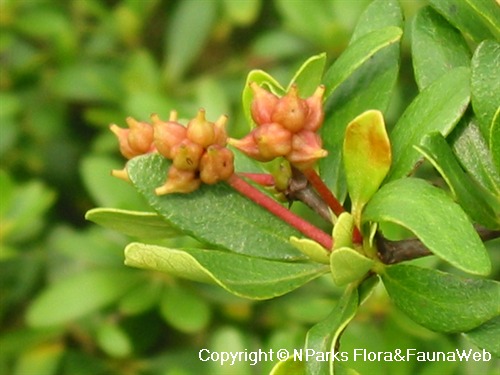
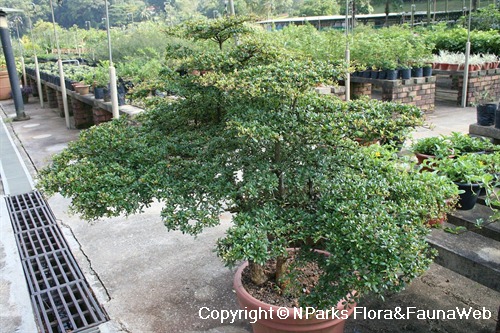




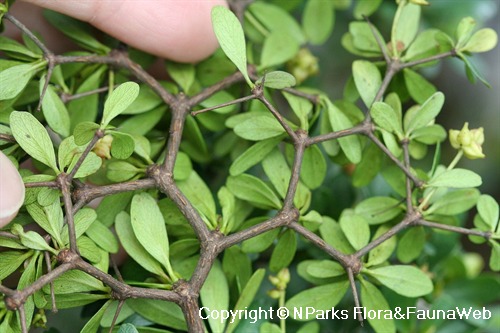

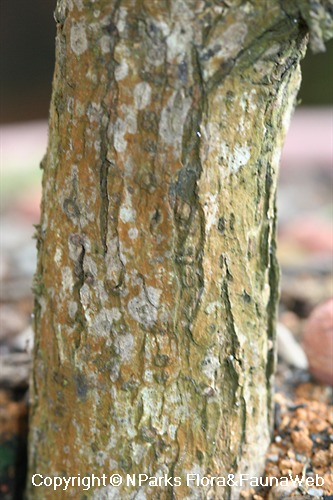
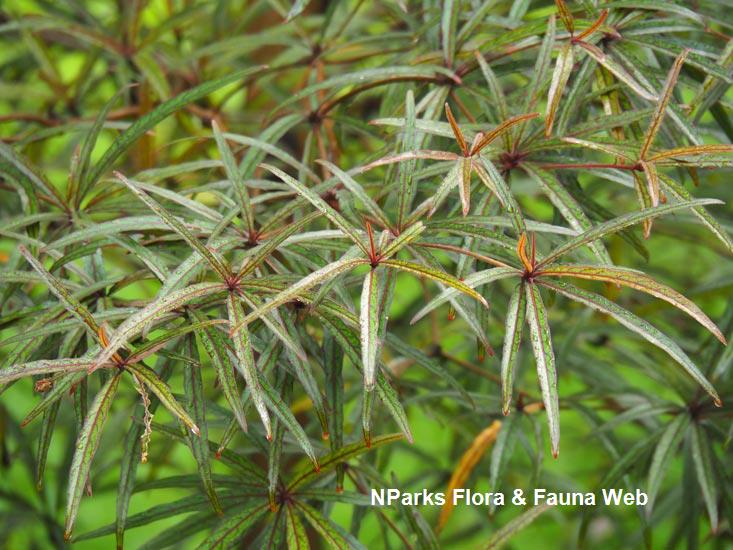
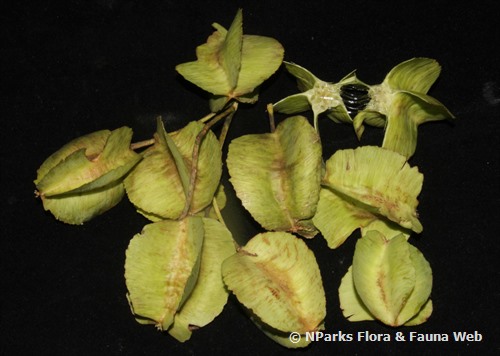
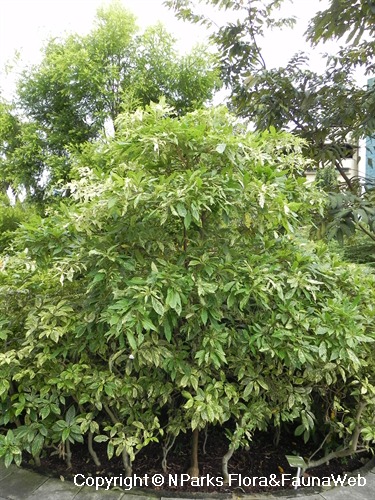
.jpg)